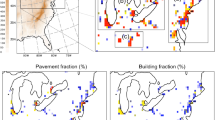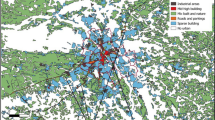Abstract
Results from the first international urban model comparison experiment (PILPS-Urban) suggested that models which neglected the anthropogenic heat flux within the surface energy balance performed at least as well as models that include the source term, but this could not be explained. The analyses undertaken show that the results from PILPS-Urban were masked by the signal from including vegetation, which was identified in PILPS-Urban as being important. Including the anthropogenic heat flux does give improved performance, but the benefit is small for the site studied given the relatively small magnitude of this flux relative to other terms in the surface energy balance. However, there is no further benefit from including temporal variations in the flux at this site. The importance is expected to increase at sites with a larger anthropogenic heat flux and greater temporal variations.






Similar content being viewed by others
References
Best MJ (2005) Representing urban areas within operational numerical weather prediction models. Boundary-Layer Meteorol 114:91–109
Best MJ, CSB G, Villani MG (2006) Evaluation of the urban tile in MOSES using surface energy balance observations. Bound- Layer Meteorol 118:503–525
Best MJ, Pryor M, Clark DB, Rooney GG, Essery RHL, Ménard CB, Edwards JM, Hendry MA, Porson A, Gedney N, Mercado LM, Sitch S, Blyth E, Boucher O, Cox PM, Grimmond CSB, Harding RJ (2011) The Joint UK Land Environment Simulator (JULES), model description—part 1: energy and water fluxes. Geosci Model Dev 4:677–699
Best MJ, Grimmond CSB (2013) Analysis of the seasonal cycle within the first international urban land surface model comparison. Bound-Layer Meteorol 146:421–446. doi:10.1007/s10546-012-9769-7
Best MJ, Grimmond CSB (2014) Importance of initial state and atmospheric conditions for urban land surface models performance. Urban Climate. doi:10.1016/j.uclim.2013.10.006
Christen A, Vogt R (2004) Energy and radiation balance of a Central European City. Int J Climatol 24:1395–1421
Coutts AM, Beringer J, Tapper NJ (2007) Impact of increasing urban density on local climate: spatial and temporal variations in the surface energy balance in Melbourne, Australia. J Appl Meteorol 47:477–493
Cullen MJP (1993) The unified forecast/climate model. Meteorol Mag 122:81–94
Grimmond CSB (1992) The subruban energy balance: Methodological considerations and results for a mid-latitude west coast city under winter and spring conditions. Int J Climatol 12:481–497
Grimmond CSB, Blackett M, Best MJ, Barlow J, Baik J-J, Belcher SE, Bohnenstengel SI, Calmet I, Chen F, Dandou A, Fortuniak K, Gouvea ML, Hamdi R, Hendry M, Kawai T, Kawamoto Y, Kondo H, Krayenhoff ES, Lee S-H, Loridan T, Martilli A, Masson V, Miao S, Oleson K, Pigeon G, Porson A, Ryu Y-H, Salamanca F, Shashua-Bar L, Steeneveld G-J, Trombou M, Voogt J, Young D, Zhang N (2010) The international urban energy balance models comparison project: first results from phase 1. J Appl Meteorol Climatol 49:1268–1292. doi:10.1175/2010JAMC2354.1
Grimmond CSB, Blackett M, Best MJ, Baik J-J, Belcher SE, Beringer J, Bohnenstengel SI, Calmet I, Chen F, Coutts A, Dandou A, Fortuniak K, Gouvea ML, Hamdi R, Hendry M, Kanda M, Kawai T, Kawamoto Y, Kondo H, Krayenhoff ES, Lee S-H, Loridan T, Martilli A, Masson V, Miao S, Oleson K, Ooka R, Pigeon G, Porson A, Ryu Y-H, Salamanca F, Steeneveld G-J, Trombou M, Voogt J, Young D, Zhang N (2011) Initial results from phase 2 of the international urban energy balance model comparison. Int J Climatol 30:244–272. doi:10.1002/joc.2227
Hallenbeck M, Rice M, Smith B, Cornell-Martinez C, Wilkinson J (1997) Vehicle volume distribution by classification. Washington State Transportation Center, University of Washington, 54 pp. [Available from Washington State Transportation Center, University of Washington, 1107 NE 45th St. Suite 535, Seattle WA 98105]
Hamdi R, Degrauwe D, Duerinckx A, Cedilnik J, Costa V, Dalkilic T, Essaouini K, Jerczynki M, Kocaman F, Kullmann L, Mahfouf J-F, Meier F, Sassi M, Schneider S, Váňa F, Termonia P (2014) Evaluating the performance of SURFEXv5 as a new land surface scheme for the ALADINcy36 and ALARO-0 models. Geosci Model Dev 7:23–39. doi:10.5194/gmd-7-23-2014
Hamilton IG, Davies M, Steadman P, Stone A, Ridley I, Evans S (2009) The significance of the anthropogenic heat emissions of London’s buildings: a comparison against captured shortwave solar radiation. Build Environ. 44:807–817
Iamarino M, Beevers S, Grimmond CSB (2012) High-resolution (space, time) anthropogenic heat emissions: London 1970–2025. Int J Climatol 32:1754–1767. doi:10.1002/joc.2390
Ichinose T, Shimodozono K, Hanaki K (1999) Impact of anthropogenic heat on urban climate in Tokyo. Atmos Environ 33:3897–3909
Kotthaus S, Grimmond CSB (2014) Energy exchange in a dense urban environment—part I: temporal variability of long-term observations in central London. Urban Climate. doi:10.1016/j.uclim.2013.10.002
Lemonsu A, Belair S, Mailhot J (2009) The new Canadian urban modelling system: evaluation for two cases from the joint urban 2003 Oklahoma city experiment. Bound- Layer Meteorol 113:47–70. doi:10.1007/s10546-009-9414-2
Manabe S (1969) Climate and the ocean circulation: 1, the atmospheric circulation and the hydrology of the earths’ surface. Mon Wea Rev 97:739–805
Martilli A, Clappier A, Rotach MW (2002) An urban surface exchange parameterisation for mesoscale models. Bound-Layer Meteorol 104:261–304
Masson V (2000) A physically-based scheme for the urban energy budget in atmospheric models. Bound-Layer Meteorol 41:1011–1026
McCarthy MP, Best MJ, Betts RA (2010) Climate change in cities due to global warming and urban effects. Geophys Res Letters 37: L09705. doi:10.1029/2010GL042845
Offerle B, Grimmond CSB, Fortuniak K (2005) Heat storage and anthropogenic heat flux in relation to the energy balance of a central european city centre. Int J Climatol 25:1405–1419. doi:10.1002/joc.1198
Oleson KW, Bonan GB, Feddema J, Vertenstein M, Grimmond CSB (2008) An urban parameterization for a global climate model: 1. Formulation and Evaluation for two Cities J Appl Meteorol Climatol 47:1038–1060
Pigeon G, Legain D, Durand P, Masson V (2007) Anthropogenic heat release in an old European agglomeration (Toulouse, France). Int J Climatol 27:1969–1981
Quah AKL, Roth M (2011) Diurnal and weekly variation of anthropogenic heat emissions in a tropical city, Singapore. Atmos Environ 46:92–103
Ross SL, Oke TR (1988) Tests of three urban energy balance models. Boundary-Layer Meteorol 44:73–96
Sailor DJ (2011) A review of methods for estimating anthropogenic heat and moisture emissions in the urban environment. Int J Climatol 31:189–199
Sailor DJ, Lu L (2004) A top-down methodology for developing diurnal and seasonal anthropogenic heating profiles for urban areas. Atmos Environ 38:2737–2748
Acknowledgments
M. Best was supported by the Joint DECC/Defra Met Office Hadley Centre Climate Programme (CA01101). Grimmond acknowledges support from Newton Fund/Met Office CSSP-China. Funds to support PILPS-Urban were provided by the Met Office (P001550). We would like to thank Andrew Coutts, Jason Beringer and Nigell Tapper for allowing their data to be used for the comparison. We would also like to thank Maggie Hendry and Mariana Gouvea for undertaking the JULES simulations for PILPS-Urban and everyone else who contributed model simulations to the comparison.
Author information
Authors and Affiliations
Corresponding author
Rights and permissions
About this article
Cite this article
Best, M.J., Grimmond, C.S.B. Investigation of the impact of anthropogenic heat flux within an urban land surface model and PILPS-urban. Theor Appl Climatol 126, 51–60 (2016). https://doi.org/10.1007/s00704-015-1554-3
Received:
Accepted:
Published:
Issue Date:
DOI: https://doi.org/10.1007/s00704-015-1554-3




